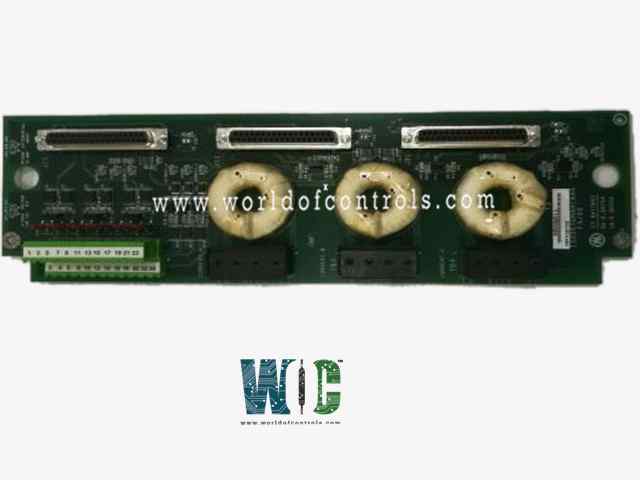
World Of Controls understands the criticality of your requirement and works towards reducing the lead time as much as possible.
IS230TGNAH1A - Turbine-Generator Terminal Board is available in stock which ships the same day.
IS230TGNAH1A - Turbine-Generator Terminal Board comes in UNUSED as well as REBUILT condition.
To avail our best deals for IS230TGNAH1A - Turbine-Generator Terminal Board, contact us and we will get back to you within 24 hours.
SPECIFICATIONS:
Part Number: IS230TGNAH1A
Manufacturer: General Electric
Series: Mark VIe
Inputs to TGNA: 3
Product Type: Turbine-Generator Terminal Board
Generator current inputs: 0 to 5 A
Analog inputs Current inputs: 4-20 mA
Analog output current: 0-20 mA
Size: 15.9 cm high x 17.8 cm wide
Frequency: 50 or 60 Hz
Repair: 3-7 Day
Availability: In Stock
Weight: 2 lbs
Country of Origin: United States
Manual: GEH-6721G
FUNCTIONAL DESCRIPTION:
IS230TGNAH1A is a Turbine-Generator Terminal Board Manufactured and designed by General Electric as part of the Mark VIe Series used in GE Distributed Turbine Control Systems. The Turbine-Generator terminal board (TGNA) acts as a signal interface board for the Mark VIe I/O pack PGEN. In the Mark VI system, the VGEN board works with TGEN. The TGNA provides a direct interface to three analog inputs for sensing turbine steam pressure and three current transformer (CT) feedbacks for sensing generator current. The three analog inputs are configurable to be 4-20 mA, +/- 5 V, or +/-10 V inputs. There are two jumpers for each analog input. One jumper is used to select either current (4-20 mA) or voltage feedback. The other jumper can optionally ground the return path for the inputs. The three CT inputs can be fed from 1 A or 5 A-rated CT outputs. A separate terminal board point is provided for the two different amp-rated inputs. Configuration parameter CT_Secondary designates which terminal board points are used. The signals are passed on to the Mark VIe I/O packs through a 37-pin connector. The TGNA can be used for either simplex or TMR applications. TMR applications fan the signal to three I/O packs.
INSTALLATION:
Voltage-output sensors should use VDCx and Retx as signal connection points. Jumper JP1(3,5) should be in the voltage I/P position. JP2(4,6) should be in the differential input position for differential feedback and the Return to the GND position for sensors supplied with the 24 V output. Configuration parameter InputUse for the analog inputs should be set according to the type of sensor being used, +/-10 V, +/-5 V, or 4-20 mA. Current-based sensors should use IDCx and Retx as signal connection points. Jumper JP1(3,5) should be in the 4-20 mA I/P position. JP2(4,6) should be in differential input position.
OPERATION:
PGEN monitors the generator's 3-phase current and turbine mechanical power to provide the PLU over-speed control for large steam turbines. Three single-phase CT inputs are provided with a normal current range of 0 to 5 A continuous or 0 to 1 A continuous. The CTs are magnetically isolated on TGNA. CTs connect to non-pluggable terminal blocks with captive lugs accepting up to #10 AWG wires. The total generator current is calculated from these inputs. The three analog inputs accept 4-20 mA input source is available for all three circuits with individual current limits for each circuit. The 4-20 mA transducers can use the +24 V dc source from the turbine control or a self-powered source. A jumper on TGNA selects between current and voltage inputs for each circuit. In a TMR system, analog inputs fan out to the three I/O packs (PGEN). The 24 V dc power to the transducers comes from all three PGEN packs and is diode-shared on the TGNA.
WOC has the largest stock of GE Distributed Turbine Control System Replacement Parts. We can also repair your faulty boards. WORLD OF CONTROLS can also supply unused and rebuilt backed-up with a warranty. Our team of experts is available round the clock to support your OEM needs. Our team of experts at WOC is happy to assist you with any of your automation requirements. For pricing and availability on any parts and repairs, kindly get in touch with our team by phone or email.
What is the purpose of a turbine-generator terminal board?
The primary purpose of a terminal board is to facilitate the safe and reliable transmission of electrical signals and power between various components within a turbine-generator system. It helps manage and distribute electrical connections effectively.
What are the typical components of a turbine-generator terminal board?
Terminal boards generally consist of terminal blocks, connectors, bus bars, and insulating materials. They are designed to withstand high electrical currents and ensure secure connections.
How is a turbine-generator terminal board installed?
Installation involves mounting the terminal board securely within the turbine-generator system, typically near the generator and other electrical components. Proper insulation and wiring techniques are essential to ensure safety and efficiency.